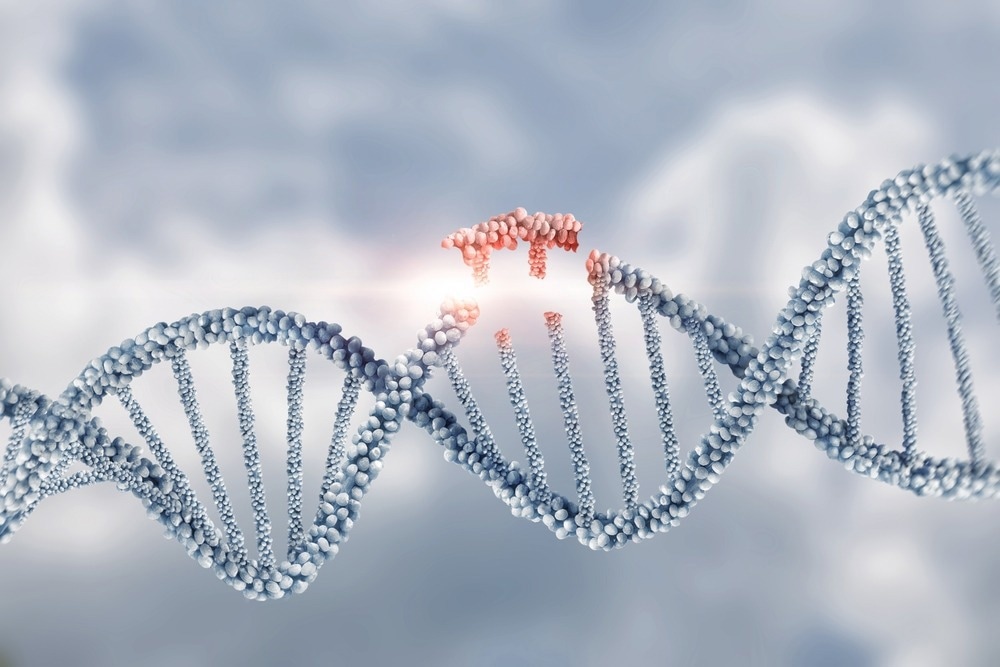In a recent study published in Signal Transduction and Targeted Therapy, Chinese researchers studied the cryo-electron microscopy structures of the CRISPR-Cas7-11 nuclease, both alone and in complex with the regulatory protein tetratricopeptide repeat fused with Cas/(human enhancer of filamentation 1) HEF1-associated signal transducer (TPR-CHAT). Their goal was to understand how TPR-CHAT modulates the activity of the nuclease.

Image Credit: Natali _ Mis/Shutterstock.com
The discovery of clustered, regularly interspaced short palindromic repeats (CRISPR) and CRISPR-associated proteins (Cas) has revolutionized gene editing due to its affordability, accuracy, and efficiency of ribonucleic acid (RNA) in editing.
Background
The CRISPR-Cas system, which has radically improved gene editing, was found in archaea and bacteria as a method of adaptive immunity against invading bacteriophages, plasmids, or mobile genetic elements.
It is now widely used for gene editing across various taxa, such as animals, plants, and human cells. The system comprises a CRISPR locus that carries out functions associated with genetic memory and the Cas protein that catalyzes the process.
Based on the effector complexes and the number of Cas proteins, the CRISPR-Cas systems are categorized into two classes, each containing three types of systems. The CRISPR-Cas7-11 system is a type III E subtype containing one Cas11 and four Cas7 proteins.
Cas7-11 is believed to interact with the TPR-CHAT regulatory protein and form the CRISPR-guided caspase complex, which has protease activity. Although Cas7-11 has proven very useful for RNA editing, understanding how TPR-CHAT modulates its nuclease activity can help broaden its utility.
About the Study
In the study, the team examined cryo-electron microscopy structures of the Cas7-11 from Desulfonema ishimotonii (Di) bound to CRISPR RNA (crRNA) (DiCas7-11-crRNA complex). The structure of the complex was examined by itself while bound to the N-terminal domain or the entire length of TPR-CHAT.
Pull-down assays, which determine the interaction between proteins, were used to understand how TPR-CHAT inhibits Cas-7-11.
The N-terminal of Cas7-11 was His-tagged, while the C-terminal of TPR-CHAT was Strep-tagged for the pull-down assay, which was conducted to investigate the complex formation between Cas7-11 and the regulatory protein. Subsequently, the researchers used an in vitro nuclease assay to validate the inhibition of Cas7-11 by TPR-CHAT.
To determine the structural basis of Cas7-11 inhibition by TPR-CHAT, pre-crRNA, and Cas7-11 were co-expressed in the absence and presence of TPR-CHAT. The resultant complexes were purified using affinity and size-exclusion chromatography. The purified complexes were then visualized through cryo-electron microscopy at different resolutions.
The obtained images of the structures of the Cas7-11-crRNA complex, the Cas7-11-crRNA-TPR-CHAT complex, and the complex with Cas7-11-crRNA bound to the N-terminal domain of TRP-CHAT were all superimposed to compare structural changes in each of the complexes. An electrophoretic mobility shift assay was also conducted to understand how inactivated Cas7-11 interacted with crRNA in the presence of full-length TPR-CHAT and the N and C terminals of TPR-CHAT.
Major Findings
The study found that TPR-CHAT performs negative regulation and modulates Cas7-11 activity by preventing the target RNA from binding to the crRNA in the Cas7-11-crRNA complex. This negative regulation is carried out through the 64 amino acids in the N terminal domain of TPR-CHAT.
The structural analysis using cryo-electron microscopy revealed that while TPR-CHAT did not change the conformation of the Cas7-11-crRNA complex, it stabilized the structure at the Cas7.4 domain and interspacing linker L2 found between domains Cas7.1 and 7.2. This stabilization of the Cas7-11-crRNA complex prevented the target RNA from binding with crRNA, resulting in lower cleavage activity of Cas7-11.
This function of TPR-CHAT was similar to the activity of anti-CRISPR proteins that regulate CRISPR-Cas activity to reduce cytotoxicity in the bacterial cells and lower off-target effects.
The researchers believe that while no off-target effects have been observed so far for the Cas7-11 system, they could potentially occur with the widespread usage of the CRISPR-Cas7-11 complex for RNA editing and impact the safe use of this system. The N-terminal domain of TRP-CHAT is a lighter, truncated form of the regulatory protein that can be used as an inhibitor of Cas7-11.
However, this inhibitory effect of the N-terminal of TRP-CHAT has only been observed in this in vitro study, and more studies using mammalian cells are required to confirm that the inhibitory effects are replicated in vivo.
Conclusions
Overall, the study found that the N-terminal domain of the regulatory protein TPR-CHAT reduces the cleavage activity of Cas7-11 in the Cas7-11-crRNA complex by stabilizing the complex's conformation and preventing crRNA from binding to the target RNA. This truncated TPR-CHAT protein can potentially regulate Cas7-11 activity in cases where off-target effects are observed.
Journal reference:
Hong, T., Luo, Q., Ma, H., Wang, X., Li, X., Shen, C., Pang, J., Wang, Y., Chen, Y., Zhang, C., Su, Z., Dong, H., & Tang, X. (2024). Structural basis of negative regulation of CRISPR-Cas7-11 by TPR-CHAT. Signal Transduction and Targeted Therapy, 9(1), 111. https://www.nature.com/articles/s41392-024-01821-4